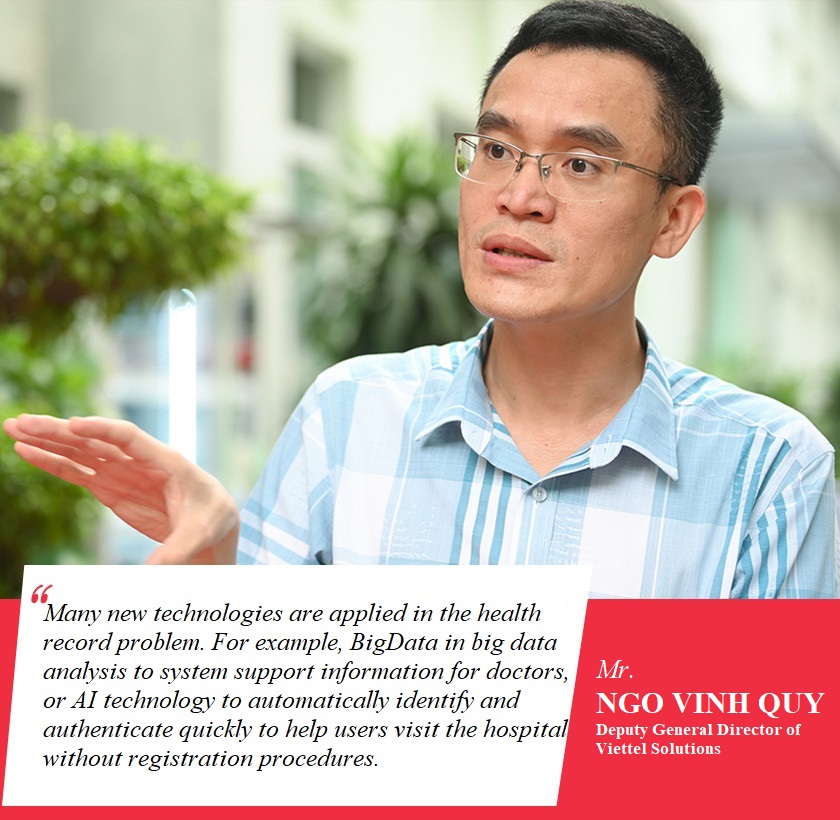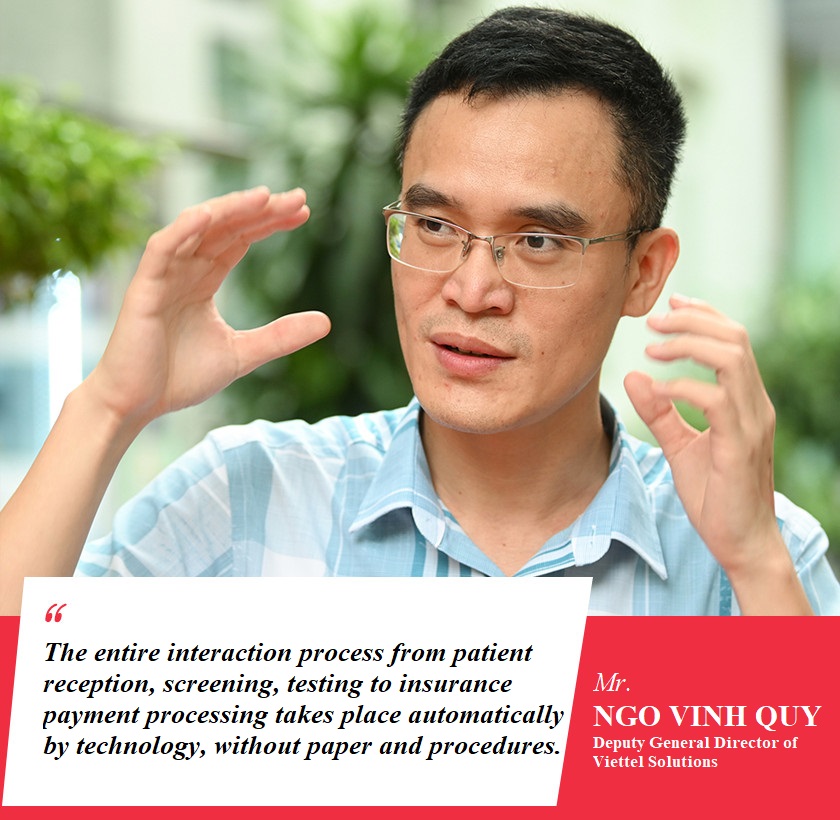The specialized characteristics of the medical field pose many difficult problems for Viettel engineers. However, with the goal of creating the "heart" of the smart health system, helping to change the entire experience of medical examination and treatment and health care of people, these problems have gradually been found.
The long-standing dream of many Vietnamese people is to always have their own doctor. That will become a reality in the near future when the Personal Health Record system, coordinated by the Ministry of Health and Viettel Group, is widely deployed.
How will this system address the wishes of the people, doctors, and change the entire healthcare industry in Vietnam?
Mr. Ngo Vinh Quy, Deputy General Director of Viettel Enterprise Solutions Corporation (Viettel Solutions) - the system builder, said that the engineers involved in the project always put the problems of the medical industry first. new to technical problems.
When receiving a request from the Ministry of Health to build a personal health record system for the health sector, what do Viettel people and engineers think about this task?
Initially, when we received this request, we were quite worried, because this is a very large system, the heart of the entire medical profession. There are not many countries in the world that have implemented such comprehensive and universal health records.
After discussing many options, we all agreed to go from the medical profession first. To do that, Viettel engineers must work closely with the Medical Examination and Treatment Administration of the Ministry of Health. From there, we understood the problems of management, communication, what is the information needed for this system, and then started to solve technical problems.
When building a personal health record system, what is the most difficult problem for Viettel engineers to solve and how has that been handled?
At first, we were very worried about the professional expertise of the medical profession. The second problem is where the ecosystem and architecture of the health record will be connected, how the data will be connected, and what technology application will be used to solve it.
This system is relatively complex but not in terms of technology but needs to be synchronized across the country. In fact, many hospitals use different systems, and there is no common communication standard.
Health records need to connect with many other systems such as health insurance to form a complete ecosystem that helps people. This is a difficulty that Viettel has solved.
So what benefits will this health record bring to the patient?
Currently, hospitals have many patient information management systems. However, the systems are relatively discrete, and a patient's data is not interconnected.
When going to the hospital, the patient must have a paper medical record, test results, and film that must be printed and carried. The reason is that all patient management systems do not use a common ID, not connected, integrated with each other but divided and broken. This fragmentation and asynchrony make it difficult for both patients and doctors to look up and learn medical history.
When Health Records are implemented, it is very convenient to have all patient information from infancy to birth and death managed on a single system. At that time, patients come to the hospital without paper, no declaration, identification technologies, and technologies integrated into the system will solve problems to help patients conveniently and quickly when medical examination and treatment.
In particular, the Personal Health Record is also connected to a number of systems of the health industry such as the management of the doctor database, the professional data of the industry, the Vietnam Social Insurance, the system of a hospital. That aims to serve the best patients.
What does this system mean for Viettel's strategy of developing digital services in the healthcare industry?
In the next 5 years, digital health is one of our spearheads. Viettel wishes to build the health sector as one of the pillars of its strategy to create a digital society. In the past 4 years, we have invested resources to build an ecosystem for the medical field; and the health record system is the heart of this ecosystem.
How is the combination of Viettel's digital solution and the expertise of medical experts in the implementation of this project?
In every field, a product or technology solution will fail if it does not understand the actual needs of users. The same goes for the medical profession. Moreover, this is a very specialized field, so many products that follow the old approach are not suitable.
Therefore, we have chosen a three-step approach. First, define the management problem for the clearest, most general, and most comprehensive. Second, build the most suitable solution and technology and model to solve this problem. Finally, implementation. This 3-step circle is applied continuously for 6-8 months to perfect, meet the actual requirements.
So when converting paper records, stored at the hospital into digital records, how is the confidentiality of patient information guaranteed?
The Personal Health Record System must comply with the 4-layer security regulation issued by the Ministry of Information & Communications. First, all systems or businesses that provide solutions must have a force in place. Second, there must be a professional data protection system. Third, there must be an independent organization or enterprise to periodically check and monitor this issue. Fourth, this system must connect, share and link with the national network security system.
At the same time, Viettel also applies 2-layer data encryption technologies to increase security. When accessing we also use options such as biometrics or OTP (One time password) to ensure that only patients can access their data.
In particular, all of Viettel's centralized data systems are monitored 24/7 in terms of information security against attacks and data leakage.
In this project, what technologies have been applied to make the system simple, smart, and convenient?

In terms of architecture, we apply Microservice architecture. This is a new technology architecture that major firms in the world are using. This architecture helps us to build open and dynamic systems.
The system does not depend on product developers, customers can completely use it according to their needs. At the same time, the open architecture also makes the Personal Health Record ready to be integrated with other systems.
In particular, many new technologies are applied in the health record problem. For example, BigData in big data analysis to system support information for doctors, or AI technology to automatically identify and authenticate quickly to help users visit the hospital without registration procedures.
In addition, we are moving to apply more technologies such as Blockchain to secure the integrity of users' personal data.
How will this system make the dream of “every citizen has a smart medical assistant” come true?
In the overall design problem of Viettel, after implementation, this system will become an electronic medical assistant for people. This system stores the entire history and index of the patient from birth to death. During the visits, patient information is stored, vital indicators are regularly updated.
Personal health records also provide people with an app on smartphones to use anytime, anywhere. The system is also equipped with simple tools so that people can check their own health through personal devices, thereby automatically connecting to the system and doctors. That helps people can check their health at any time. Not only that, but this system also actively warns if the user's health shows signs of abnormality.
When the Health Record has not been deployed, a person needs to see a doctor, all his health information is not available or incomplete or fragmentary. The doctor must examine the procedure from the beginning to check and assess the situation.
However, if there is a Health Record, all patient information so far has been stored. The ophthalmologist can know the patient's history, current symptoms and can quickly order a diagnosis or further examination and advice to the patient.
People's data in this health record will be entered into the system by the doctor when the patient visits. Each person can also self-check periodically with simple instructions and manually input information into the system. Some personal devices are automatically connected to the system when measuring, such as electrocardiograms or blood pressure measurements. When the implementation is complete, the imaging system at the hospital is also automatically synchronized, attached to the health record.
The reality is that at hospitals, people spend a lot of time waiting for tests and scans, while the doctor's consultation time is only a few minutes. That proves that we do not have a connection between systems in the health sector. So, when implementing the Personal Health Record system, how will this be resolved?
We aim for a hospital with no paperwork, no scans, and no waiting. Specifically, the picture for the future is that patients book appointments in advance. Upon arrival at the hospital, the system will automatically identify the patient, through new technologies authenticated by a unique medical identifier that connects to the Personal Health Record and related systems.
For example, if a patient is assigned to take a film or take a test, the system will actively message the appointment and return the results through communication channels such as apps, messages.

Thus, the entire interaction process from patient reception, screening, testing to insurance payment processing takes place automatically by technology, without paper and procedures.
After putting the system into practice in some hospitals, we have received many positive feedbacks from doctors and managers. Besides, some comments on the expertise of experts in this field will help Viettel engineers to improve the product better.